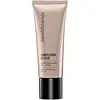bareMinerals Complexion Rescue Tinted Hydrating Gel Cream SPF30 Versus Nudestix Nudescreen Daily Mineral Veil SPF 30 - Cool
What's inside
What's inside
 Key Ingredients
Key Ingredients

 Benefits
Benefits

 Concerns
Concerns

 Ingredients Side-by-side
Ingredients Side-by-side

Water
Skin ConditioningCoconut Alkanes
EmollientPropanediol
SolventTitanium Dioxide
Cosmetic ColorantSqualane
EmollientSorbitan Sesquiisostearate
EmulsifyingIsostearic Acid
CleansingPolysorbate 60
EmulsifyingTrehalose
HumectantGlycerin
HumectantAgar
MaskingSilica
AbrasiveMoringa Oleifera Seed Extract
Skin ConditioningSalicornia Herbacea Extract
Skin ConditioningMelilotus Officinalis Extract
AstringentTheobroma Cacao Seed Extract
AntioxidantCoco-Caprylate/Caprate
EmollientCaprylic/Capric Triglyceride
MaskingCaffeine
Skin ConditioningLauroyl Lysine
Skin ConditioningSuccinoglycan
Skin ConditioningAluminum Hydroxide
EmollientHydrogen Dimethicone
Citric Acid
BufferingDisodium Phosphate
BufferingAcetyl Tetrapeptide-5
HumectantButylene Glycol
HumectantPolyglyceryl-4 Laurate/Succinate
Cellulose Gum
Emulsion StabilisingMagnesium Chloride
Calcium Chloride
AstringentPotassium Chloride
Sodium Hyaluronate
HumectantMagnesium Stearate
Cosmetic ColorantPhenoxyethanol
PreservativeMica
Cosmetic ColorantCI 77491
Cosmetic ColorantCI 77492
Cosmetic ColorantCI 77499
Cosmetic ColorantCI 77891
Cosmetic ColorantWater, Coconut Alkanes, Propanediol, Titanium Dioxide, Squalane, Sorbitan Sesquiisostearate, Isostearic Acid, Polysorbate 60, Trehalose, Glycerin, Agar, Silica, Moringa Oleifera Seed Extract, Salicornia Herbacea Extract, Melilotus Officinalis Extract, Theobroma Cacao Seed Extract, Coco-Caprylate/Caprate, Caprylic/Capric Triglyceride, Caffeine, Lauroyl Lysine, Succinoglycan, Aluminum Hydroxide, Hydrogen Dimethicone, Citric Acid, Disodium Phosphate, Acetyl Tetrapeptide-5, Butylene Glycol, Polyglyceryl-4 Laurate/Succinate, Cellulose Gum, Magnesium Chloride, Calcium Chloride, Potassium Chloride, Sodium Hyaluronate, Magnesium Stearate, Phenoxyethanol, Mica, CI 77491, CI 77492, CI 77499, CI 77891
Zinc Oxide 15%
Cosmetic ColorantWater
Skin ConditioningCoconut Alkanes
EmollientCaprylic/Capric Triglyceride
MaskingPropanediol
SolventCoco-Caprylate/Caprate
EmollientPolyglyceryl-4 Diisostearate/Polyhydroxystearate/Sebacate
EmulsifyingMethyl Dihydroabietate
Spirulina Platensis Extract
Skin ProtectingC13-15 Alkane
SolventSodium Chloride
MaskingDistarch Phosphate
AbsorbentIsostearic Acid
CleansingPolyhydroxystearic Acid
EmulsifyingQuaternium-90 Bentonite
1,2-Hexanediol
Skin ConditioningBenzyl Alcohol
PerfumingHydroxyacetophenone
AntioxidantZinc Stearate
Cosmetic ColorantEthyl Ferulate
AntioxidantTriethyl Citrate
MaskingButylene Glycol
HumectantLactobacillus Ferment
Skin ConditioningPassiflora Edulis Fruit Extract
Skin ConditioningCamellia Sinensis Leaf Extract
AntimicrobialZinc Oxide 15%, Water, Coconut Alkanes, Caprylic/Capric Triglyceride, Propanediol, Coco-Caprylate/Caprate, Polyglyceryl-4 Diisostearate/Polyhydroxystearate/Sebacate, Methyl Dihydroabietate, Spirulina Platensis Extract, C13-15 Alkane, Sodium Chloride, Distarch Phosphate, Isostearic Acid, Polyhydroxystearic Acid, Quaternium-90 Bentonite, 1,2-Hexanediol, Benzyl Alcohol, Hydroxyacetophenone, Zinc Stearate, Ethyl Ferulate, Triethyl Citrate, Butylene Glycol, Lactobacillus Ferment, Passiflora Edulis Fruit Extract, Camellia Sinensis Leaf Extract
 Reviews
Reviews

Ingredients Explained
These ingredients are found in both products.
Ingredients higher up in an ingredient list are typically present in a larger amount.
Butylene Glycol (or BG) is used within cosmetic products for a few different reasons:
Overall, Butylene Glycol is a safe and well-rounded ingredient that works well with other ingredients.
Though this ingredient works well with most skin types, some people with sensitive skin may experience a reaction such as allergic rashes, closed comedones, or itchiness.
Learn more about Butylene GlycolThis ingredient is an emollient, solvent, and texture enhancer. It is considered a skin-softener by helping the skin prevent moisture loss.
It helps thicken a product's formula and makes it easier to spread by dissolving clumping compounds.
Caprylic Triglyceride is made by combining glycerin with coconut oil, forming a clear liquid.
While there is an assumption Caprylic Triglyceride can clog pores due to it being derived from coconut oil, there is no research supporting this.
Learn more about Caprylic/Capric TriglycerideCoco-Caprylate/Caprate is created from fatty coconut alcohol, caprylic acid, and capric acid.
It is a lightweight emollient. Emollients create a thin barrier on the skin to trap moisture in. This helps keep your skin hydrated and soft.
Once applied, Coco-Caprylate/Caprate is absorbed quickly and leaves a silky feel.
Coco-Caprylate/Caprate may not be fungal acne safe.
Learn more about Coco-Caprylate/CaprateCoconut Alkanes is created from the fatty-acids of coconut oil. It is volatile, meaning it evaporates from the skin.
This ingredient is an emollient and solvent. As an emollient, it helps keep skin soft and hydrated. Solvents help distribute and mix other ingredients. This ensures a more even consistency.
Coconut Alkanes may not be fungal-acne safe.
Learn more about Coconut AlkanesIsostearic acid is a saturated fatty acid. Its structure makes it a great surfactant.
Surfactants help decrease the surface tension between two liquids. This property also makes it an effective emulsifier. Emulsifiers help prevent waters and oils from separating in a product.
Isostearic Acid is created from oleic acid.
This ingredient may not be Malassezia folliculitis, or fungal-acne safe.
Learn more about Isostearic AcidPropanediol is an all-star ingredient. It softens, hydrates, and smooths the skin.
It’s often used to:
Propanediol is not likely to cause sensitivity and considered safe to use. It is derived from corn or petroleum with a clear color and no scent.
Learn more about PropanediolWater. It's the most common cosmetic ingredient of all. You'll usually see it at the top of ingredient lists, meaning that it makes up the largest part of the product.
So why is it so popular? Water most often acts as a solvent - this means that it helps dissolve other ingredients into the formulation.
You'll also recognize water as that liquid we all need to stay alive. If you see this, drink a glass of water. Stay hydrated!
Learn more about Water